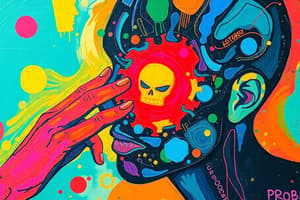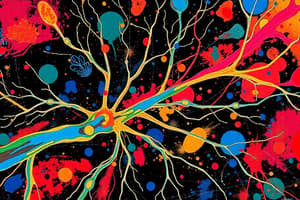Podcast
Questions and Answers
What does the acronym 'ADME' stand for in pharmacokinetics?
What does the acronym 'ADME' stand for in pharmacokinetics?
- Absorption, Demarcation, Modulation, Excitation
- Absorption, Distribution, Metabolism, Excretion (correct)
- Activation, Defense, Metabolism, Elimination
- Administration, Distribution, Mechanism, Elimination
Which of the following is NOT a type of seizure?
Which of the following is NOT a type of seizure?
- Absence seizure
- Hypertonic seizure (correct)
- Generalized tonic-clonic seizure
- Myoclonic seizure
What does the term 'therapeutic index' refer to?
What does the term 'therapeutic index' refer to?
- The ratio between the minimum effective dose and the minimum toxic dose (correct)
- The maximum concentration a drug can achieve in the bloodstream
- The range of doses that produce side effects
- The value representing a drug's absorption rate
What does a black box warning on a drug label signify?
What does a black box warning on a drug label signify?
What does the term 'paroxysmal depolarization shift' (PDS) refer to in seizure activity?
What does the term 'paroxysmal depolarization shift' (PDS) refer to in seizure activity?
What distinguishes chronic pain from acute pain?
What distinguishes chronic pain from acute pain?
Which term refers to increased sensitivity to pain, commonly seen in chronic pain sufferers?
Which term refers to increased sensitivity to pain, commonly seen in chronic pain sufferers?
Which of the following accurately describes the nociceptors?
Which of the following accurately describes the nociceptors?
What effect do opioids primarily have on pain modulation?
What effect do opioids primarily have on pain modulation?
Which of the following conditions can be associated with neuropathic pain?
Which of the following conditions can be associated with neuropathic pain?
Which pharmacological agents are known to modulate the TRPV1 channels involved in pain perception?
Which pharmacological agents are known to modulate the TRPV1 channels involved in pain perception?
What is one limitation of targeting a single nociceptor mechanism for pain management?
What is one limitation of targeting a single nociceptor mechanism for pain management?
Which type of pain pathway is primarily concerned with emotional aspects of pain perception?
Which type of pain pathway is primarily concerned with emotional aspects of pain perception?
Flashcards
Acute Pain
Acute Pain
Short-term pain signaling tissue damage or injury.
Chronic Pain
Chronic Pain
Persistent pain lasting longer than expected after injury has healed.
Neuropathic Pain
Neuropathic Pain
Pain due to damage or dysfunction in the nervous system.
Inflammatory Pain
Inflammatory Pain
Signup and view all the flashcards
Nociceptors
Nociceptors
Signup and view all the flashcards
Pain Pathway
Pain Pathway
Signup and view all the flashcards
Descending Pathways
Descending Pathways
Signup and view all the flashcards
Pain Modulation
Pain Modulation
Signup and view all the flashcards
Types of Seizures
Types of Seizures
Signup and view all the flashcards
Neuropharmacology of Seizures
Neuropharmacology of Seizures
Signup and view all the flashcards
ADME in Pharmacokinetics
ADME in Pharmacokinetics
Signup and view all the flashcards
Drug Administration Routes
Drug Administration Routes
Signup and view all the flashcards
Pharmacovigilance
Pharmacovigilance
Signup and view all the flashcards
Study Notes
Lecture 6 (October 21): Key Study Points
- Understand pain's role within the somatosensory system and the difference between acute and chronic pain.
- Differentiate neuropathic and inflammatory pain, and recognize relevant conditions (e.g., allodynia, hyperalgesia, spontaneous pain).
- Identify factors influencing pain perception beyond typical pain pathways.
- Describe the pain pathway, from primary sensory afferents to the cortex, and define nociceptors.
- Detail descending pathways and how the rostral ventromedial medulla (RVM) regulates pain.
- Outline various pharmacological approaches (e.g., opioids, cannabinoids, antidepressants, NMDA antagonists) to modulate pain, including roles of specific ion channels (NaV1.7 and TRPV1).
- Understand limitations of targeting single nociceptor receptors.
- Identify examples of anti-inflammatory drugs and their mechanisms of action.
- For somatosenses/pain, focus on learning objectives 7.15, 7.16, and 7.17.
- Understand pain pathways linked to sensory and emotional components.
- Understand opioid-induced analgesia (Figure 7.31). Avoid placebo analgesia and phantom limb pain for now (will be covered later).
- Focus on the entire learning objective 16.2 related to Seizure Disorders (chapter 16.1).
- Differentiate various seizure types (convulsive and non-convulsive). Identify examples of seizure causes and related pathways.
- Understand neuropharmacological aspects, especially excitation, inhibition, and the paroxysmal depolarization shift (PDS).
- Summarize interictal periods and current treatment approaches.
- Define ADME (in relation to pharmacokinetics).
- Describe different drug-administration routes and rationales.
- Explain Cmax, Cmin, Tmax, T1/2, and F (bioavailability).
- Understand why F% is important in drug efficacy.
- Define side effects and their causes, focusing on pharmacovigilance studies.
- Understand drug labels and black box warnings.
- Evaluate therapeutic indexes and their importance based on disease factors.
Studying That Suits You
Use AI to generate personalized quizzes and flashcards to suit your learning preferences.
Related Documents
Description
This quiz focuses on key concepts from Lecture 6 regarding the role of pain within the somatosensory system. It covers the differences between acute and chronic pain, as well as neuropathic and inflammatory pain. Additionally, the quiz explores pain pathways, nociceptors, and pharmacological approaches to pain modulation.




